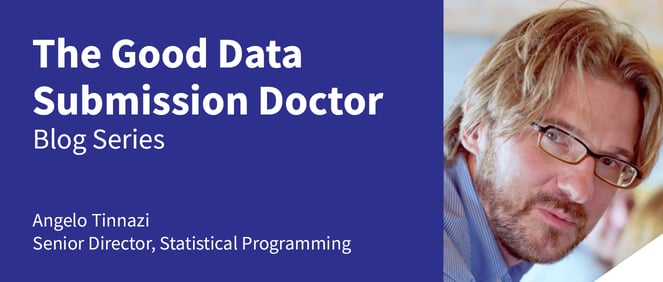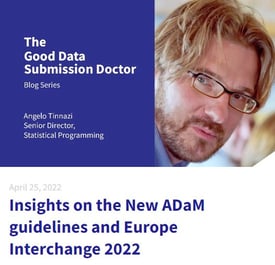CDISC SDTM and ADaM: An Explosive 2021 Ending!


Recently, on November 29 I received an email from CDISC announcing an important update for both SDTM and ADaM CDISC models: in one single day CDISC was able to release for both SDTM [1,2] and ADaM [3], a new Implementation Guidance (IG) along with other related documents, and also a new version of the standard for SDTM. The following table summarizes the release:
| Standard | Updated Content |
| SDTM |
|
| ADaM |
|
Together with the above updates, both SDTM and ADaM teams were able to release the updated conformance Rules. All the new standards and IGs are available in the CDISC Library.
What’s new in ADaM
The “family” of ADaM documentation has been now enriched with two new elements:
- ADaM IG for Medical Device: this IG introduces an adapted version of the three standard ADaM classes (ADDL for ADSL, MDBDS for BDS and MDOCCDS for OCCDS) to support the typical statistical analysis needs for clinical trials using medical devices. If you want a nice summary of the IG and real examples, I recommend the paper from PharmaSUG 2021 co-authored by my colleague Silvia Faini[4].
- ADaM IG for Non-Compartmental Analysis (NCA): this IG does not introduce any new ADaM class but rather provides examples of BDS dataset, ADNCA (Data for Non-Compartmental Analysis), with the addition of new standard variables specific to NCA such as, flags to identify records not included in the analysis, additional dosing variables, etc. It should be noted that this does not imply that naming conventions are required for the name of the ADaM dataset.
The new ADaM Structure for Occurrence Data (OCCDS) version 1.1 contains three additional examples:
- Analysis of Adverse Events that Change over Time for example, when the sponsor has decided to track changes of severity, causality, or seriousness in an FAAE (Findings About Adverse Events) SDTM domain
- Analysis of Adverse Events from Multiple Input Domains for example, when in a study the individual occurrences of an event of interest are tracked in CE (Clinical Events) but then analyzed together with other adverse events stored in AE (Adverse Events) SDTM domain
- Analysis of Protocol Deviations putting the emphasis on the need to have strong metadata traceability when data-point traceability is not feasible especially, when an ADaM dataset is derived from multiple sources e.g., SDTM and ADaM datasets
In addition to the three examples above, the new version of the OCCDS introduces some new “indexed” variables e.g., TREMxxFL, where there are multiple periods analysis needs (Example 4, Analysis of Treatment-emergent Adverse Events in a Cross-Over Interaction Study, has been modified to show the use of these new variables). Moreover, in the “Introduction” section of the document it is clarified that in some instances the number of records in an OCCDS dataset might not match the number of records in the source SDTM dataset, when for example –OCCUR=’N’ in the source SDTM dataset; the following does not apply to the new define 2.1 SubClass “ADVERSE EVENT”.
Finally, the new IG (1.3) documents do not contain any major updates nor any new standard variables, with mainly changes to or addition of text to clarify topics or guidance already available in previous versions of the IG. All the above new IGs are also listed in the ADaM IG.
What’s new in SDTM
Covering all the changes in the new standard (2.0) and the new IG (3.4) in one blog post is difficult and it also requires a more in-depth review of the released documents, although CDISC provides a “Diff” file with details of changes made to each individual domain.
However, from all the updates I would like to mention the availability of new domains:
- From the SDTM PGx IG, the BE (Biospecimen Events), BS (Biospecimen Findings), GF (Genomics Findings) and RELSPEC (Related Specimens) domains (GF was previously named PF in the SDTM PGx IG). Of note, most of the content of the SDTM PGx has been incorporated in the IG 3.4 and therefore the SDTM PGx is now deprecated
- CP (Cell Phenotype Findings)
As anticipated in the SDTM IG 3.3, the dataset MO (Morphology) has been deprecated and replaced by separated specific morphology findings domains organized by body systems e.g., CV for Cardiovascular System physiological and morphological findings.
Moreover, the SV (Subject Visits) domain now incorporates variables that were proposed with the VE (Visit Events) domain in the draft “Guidance for Ongoing Studies Disrupted by COVID-19 Pandemic”[5] , which also includes new standard SDTM variables such as, SVEPCHGI (Epi/Pandemic Related Change Indicator) and is available now in the SDTM standard model version 2.0; the domain now also allows the recording of non-occurred planned visits. The SV domain was previously a special-purpose domain and now, according to the SDTM standard version 2.0, it has been moved to an Events class domain; however, the SDTM IG 3.4 still lists the domain under the special-purpose domains and the same in the supplied metadata.
CDISC and Cytel in 2022
At Cytel, my colleague Silvia Faini and I will continue to help CDISC in 2022 with organizing the CDISC European Interchange (currently the event is planned to be live in Copenhagen 27-28 April and you are all invited to submit your abstract-proposal by the end of this week) and organizing the IX CDISC Italian Speaking User Network Meeting, after the successful VIII edition held on December 3, 2021 (full copy of slides available in the CDISC Wiki [6]).
References:
[1] SDTM Implementation Guidance Version 3.4
[2] SDTM Version 2.0
[3] ADaM Version 2.1 and ADaM Implementation Guidance Version 1.3
[4] ADaM Implementation Guide for Medical Devices, J. Yang, K. LaPann, S. Faini; PharmaSUG 2021
[5] CDISC Guidance for Ongoing Studies Disrupted by COVID-19 Pandemic
[6] CDISC Italian User Network Page
Read more from The Good Data Submission Doctor series:
About Angelo Tinazzi
 Angelo Tinazzi is Senior Director, Statistical Programming, Clinical Data Standards and Clinical Data Submission at Cytel. He is a well- published and recognized expert in statistical programming with over 20 years' experience in clinical research. The application of CDISC standards in different therapeutic areas is part of his core expertise since 2003 in particular in the context of data submission to health authorities such as the FDA and PMDA.
Angelo Tinazzi is Senior Director, Statistical Programming, Clinical Data Standards and Clinical Data Submission at Cytel. He is a well- published and recognized expert in statistical programming with over 20 years' experience in clinical research. The application of CDISC standards in different therapeutic areas is part of his core expertise since 2003 in particular in the context of data submission to health authorities such as the FDA and PMDA.
Angelo is an authorized CDISC instructor and member of the CDISC ADaM Team as well as the CDISC European Committee where he also manages the Italian-speaking CDISC User Network.




